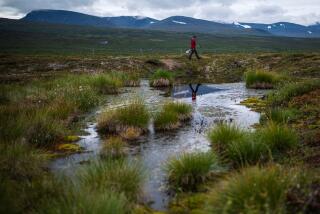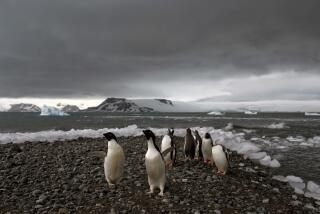Ice Retains Earth’s Climate History : Ecology: Scientists are drilling in Greenland, Antarctica and the Tibetan Plateau in effort to learn more about the planet’s weather and answer questions about global warming.
- Share via
Braving frigid blasts and bouts of altitude sickness, scientists are drilling for ancient ice in some of the world’s most inhospitable places.
The ice cores they are extracting from Greenland, Antarctica and the lofty Tibetan Plateau will contain records of changes in Earth’s climate over hundreds of thousands of years. The cores also should help answer questions about global warming.
Eventually, snows that fell as long as a million years ago may be analyzed to see what the climate was like then.
More than 28,000 feet of ice cores from various depths and locations are stored in 3.3-foot-long aluminum cylinders at the National Ice Core Laboratory in Denver, a facility run by the U.S. Geological Survey, the National Science Foundation and the University of Colorado. Instrumentation at the repository gives visiting scientists an opportunity to examine the cores.
“Hopefully we’ll go back about 250,000 years with the cores now being collected in Greenland,” said Joan Fitzpatrick, technical director of the laboratory. “Ice is the only medium that enables us to get such a detailed record of the climate for such long periods.”
The frozen cylinders also reveal the dates of violent events such as volcanic eruptions.
Analyzing volcanic acids and ash frozen in Greenland cores, scientists discovered that the explosion of Mt. Mazama, which created Oregon’s Crater Lake, occurred in 4401 B.C.
A blast pinpointed to 1390 B.C. may have been one of several that spelled the end of an ancient civilization on Thera, a Greek island in the Aegean Sea.
Locations are unclear, but there was also evidence of seven different great eruptions somewhere on Earth between 7911 and 7090 B.C.
“One of the things we don’t realize is how short in time man has been documenting what is happening on this planet,” said Lonnie G. Thompson, a geologist at Ohio State University’s Byrd Polar Research Center. “Only in these frozen archives can we look and get the perspective that we need to assess what’s happening in the 20th Century.”
Some experts believe that increased levels of greenhouse gases, such as carbon dioxide, are producing a dangerous global warming trend. Others argue that the higher temperatures occur because of natural climatic variations over long periods of time. The ice cores could help resolve the debate.
Atmospheric gases and aerosols are captured in snow and retained in the snowpack as it turns into ice. Analysis of the particles and the tiny bubbles created by the gases in the ice provides a chronicle of the changes in air and sea temperatures, precipitation, amounts of greenhouse gases and even deviations in solar activity.
Cores drilled at the former Soviet Union’s Vostok research station in East Antarctica have indicated the long-term impact of carbon dioxide. During key periods in the last 170,000 years, carbon dioxide and temperatures have risen and fallen together.
“The ice cores showed for the first time that when temperatures were low, there was a low concentration of greenhouse gases,” said Pieter Grootes, a physics and geology professor at the University of Washington. “There is indication of a link between global temperatures and greenhouse-gas concentrations.”
A similar picture is emerging in Greenland, where drills operated by U.S. and European scientists have reached down nearly 10,000 feet to the bottom of the ice sheet.
“The measurements we have definitely demonstrate that greenhouse gases such as methane and carbon dioxide seemed to increase during warm periods in the last 40,000 years,” said Paul Mayewski, chief scientist for the U.S. Greenland project.
“In the current warm period of the last 100 years, the levels have risen much higher than they ever do naturally. There’s no doubt at all that there is an association between greenhouse gases and temperature.”
But it still hasn’t been resolved whether higher amounts of the gases resulted in the temperature changes.
“I don’t think we know if carbon dioxide is the ultimate cause of this climate change,” said Eric S. Saltzman, a specialist in marine and atmospheric chemistry at the University of Miami who has worked on the Vostok cores.






